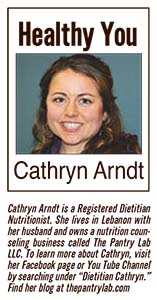It is difficult to believe that June is here and summer is almost upon us.
It almost feels like we have skipped spring entirely, thanks to the strange, extended winter hibernation instigated by the COVID-19 quarantine. Yet the natural world has blossomed and, gratefully, our communities are as well, as we learn what “unquarantin-ing” looks like.
Some of us have developed rather sloppy eating habits as we have tried to deal with the chaotic changes and emotions that COVID has introduced into our lives. “Detox” and a “cleanse” are words that are flying around. Many feel like they need a reset and a clean-out from all the less-than-ideal foods they’ve been consuming.
Overused and misunderstood, detoxification is a concept that solicits a lot of hype but is also surrounded by much confusion. We use the word but do we know what it is? Or what it does? Let’s get clear on what detox is. Detoxification is indeed real and supporting it has implications for your diet.
As mystical as the process of detoxification sounds, simply put, it is the naturally occurring process of breaking down and eliminating used and unwanted fatty substances from the body. We call these unwanted substances “toxins.”
These toxins are chemicals that originate from both outside the body (from medications, caffeine, alcohol, cosmetic products applied to the skin, etc.) and inside the body (from byproducts of metabolic reactions, used hormones, etc).
Since these toxins are fatty substances (i.e. fat-soluable), they won’t mix with your blood and need to change into a form that can.
Six organs in your body are responsible for processing and eliminating toxins: the liver, gastrointestinal (GI) tract, kidneys, skin, lungs and lymphatic system.
The Liver in Detox
Let’s take a deeper look at the liver’s role in detox. It matters a lot.
The method of detox in the liver is a two-step process that is officially titled Phase 1 and Phase 2 (highly original and creative, I know).
Phase 1 uses enzymes (also sometimes referred to as the Cytochrome P450 enzymes) to break down the toxins from their fatty form to a non-fatty form. We call this going from insoluble to soluble. Picture this part of the process like getting ready for a black tie event. You have to change from your everyday clothes to your fancy attire; otherwise, they won’t let you in.
Phase 2 of liver detox (also called the conjugation pathway) adds a “chemical tail” to the by-products of Phase 1. This is important if the toxin is to be removed from the body properly. Using our party analogy, this is the part where your escort shows up to take you to the black tie event. Once the ex-toxins are in the right form and have the right chemical tail, they are ready to be removed via the urine or stool. If toxins are not removed, they recirculate and can get stored in fatty tissue such as the liver, nervous system and even brain.
This natural process of the liver is working each day and is a process you can’t necessarily “make” happen. There is a lot of deceptive marketing out there that attempts to convince you that you need something more than your liver (and the other detoxing organs) in order to detox. The truth is, you don’t need more than your liver. What you do need is to support your liver as it does its job. Additionally, you also need to stop inhibiting your liver from detoxifying well. The astonishing thing is that this happens largely due to the foods you eat.
How so? Well, the entire detoxification process is nutrient-dependent. This basically means that you must have enough of the right nutrients in order to detox. For example, if you don’t have enough B vitamins, zinc, sulfur, magnesium, etc., you won’t be able to efficiently detox. Supplying these nutrients is one of the pillars of detoxing.
This is what I would comfortably call a true “simple detox diet;” one that supports the liver with nutrients needed to detoxify while decreasing the foods that hinder the process. To get the most benefit, it is best viewed as a lifestyle approach rather than a three week fix (although there are times when some people need extra support for a specific amount of time. This ought to be directed by a healthcare professional).
So what foods supply the nutrients necessary for detox? Here is a short list. Remember that this is a habitual thing not a one-food approach. Pick your top 3 – 5 foods to incorporate on a weekly if not daily basis.
Foods to focus on for daily detoxification support
Cruciferous Vegetables: Cruciferous veggies include cabbage, cauliflower, broccoli, brussels sprouts, bok choy and all varieties of kale. These veggies are superstars when it comes to metabolizing excess hormones and their byproducts. These are particularly good for menopausal women or those with estrogen dominance.
Herbs and Bitter Greens: cilantro, parsley, rosemary and dandelion. A multitude of compounds are at work in these humble greens. Use fresh, organic whenever possible.
Garlic and Onions: The same stink that permeates your breath after you eat these is the very compound necessary for detox to run smoothly – sulfur. Use fresh forms of these as much as possible. Add them to soups, salads, and egg scrambles.
High-Fiber Foods: Fiber binds to toxins and removes them from the body. Try high-fiber foods like chia seeds, flaxseed meal, steel cut or rolled oats, and beans and lentils.
Roasted Asparagus with and Toasted Nuts
Enjoy the seasonal asparagus that is so plentiful at this time of year. It is simple and has detox-supporting ingredients! This recipe was adapted from one of my favorite cookbooks, the Longevity Kitchen by Rebecca Katz.
MAKES 4 SERVINGS
PREP TIME: 15 minutes
COOK TIME: 10 minutes
Ingredients
1/3 cup hazelnuts, walnuts or pistachios
2 bunches asparagus (about 2 pounds), tough ends snapped off and discarded, then peeled (see note)
2 tablespoons plus 2 teaspoons extra-virgin olive oil
Sea salt
2 tablespoons freshly squeezed lemon juice
Freshly ground pepper
4 cups loosely packed arugula
Preheat the oven to 400°F.
Directions
Place the hazelnuts (or walnuts/pistachios) on a rimmed baking sheet. Place them in the oven for 5 to 7 minutes as it preheats, until aromatic and browned. Transfer to a plate or, if you’d like to remove the hazelnut skins for a more refined texture and appearance, wrap them in a towel and give them a good rub. The majority of the skins will come right off. Coarsely chop the nuts.
Put the asparagus on the same baking sheet in a single layer.
Drizzle with the 2 teaspoons of olive oil and generously sprinkle with salt. Toss gently to evenly coat the asparagus.
Bake for 8 minutes, until just barely tender.
Put the lemon juice, the 2 tablespoons of olive oil, 1/4 teaspoon of salt, and a few grinds of pepper in a small bowl and mix well with a small whisk.
Add more dressing to taste.
Variation: Turn this into a more filling spring salad by adding asparagus mixture and extra dressing to 4 cups of baby greens! Serves 4
– Cathryn Arndt is a registered dietitian nutritionist. She lives in the Lebanon area with her husband and toddler. She owns a nutrition counseling business called The Pantry Lab LLC. To learn more about Cathryn, visit her at her Facebook page or You Tube Channel by searching under “Dietitian Cathryn.” Find her blog at thepantrylab.com.





